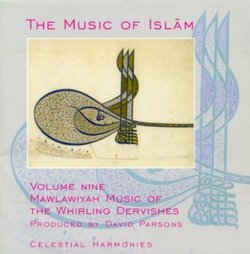| All Artists: Galata Mevlevi & Sema Ensemble Title: Music of Islam 9: Mawlawiyah Whirling Dervishes Members Wishing: 1 Total Copies: 0 Label: Celestial Harmonies Release Date: 12/2/1997 Genres: Folk, International Music, Pop Styles: Traditional Folk, Middle East, Turkey, Islamic Number of Discs: 1 SwapaCD Credits: 1 UPC: 013711314922 |
Search - Galata Mevlevi & Sema Ensemble :: Music of Islam 9: Mawlawiyah Whirling Dervishes
 | Galata Mevlevi & Sema Ensemble Music of Islam 9: Mawlawiyah Whirling Dervishes Genres: Folk, International Music, Pop
Ten years in the making, The Music of Islam series recorded in Egypt, Morocco, Tunisia, Turkey, Yemen, Pakistan, Indonesia, Iran and Qatar represents the most comprehensive sound documentation available to Westerners to... more » |
Larger Image |
CD DetailsSynopsis
Album Description Ten years in the making, The Music of Islam series recorded in Egypt, Morocco, Tunisia, Turkey, Yemen, Pakistan, Indonesia, Iran and Qatar represents the most comprehensive sound documentation available to Westerners today, of a world religion dating back to 1/622. Although governed by strict rules for fourteen centuries, contact with other cultures has radically affected Islamic music throughout history. As the world enters the XV/21st century the timing of this collection serves an even larger purpose, documenting the traditions that have survived and will continue to survive for centuries to come. Today, one fifth of the world's population, one billion people, are Muslims, occupying a large territory stretching from the Atlantic shore of north and west Africa, through west, central, and south Asia to island southeast Asia, and attracting an increasing following in India, western Europe, north America, east Asia, and southern Africa. This is a global presence which cannot be ignored.Sufism, the mystical branch of Islam, has long had a tradition of art music, and one of the most celebrated mystical traditions in the world, that of the Mevlevi dervishes, evolved in Turkey. Mevlevi or Mawlawiyah music, developed in the VII/13th century and nurtured by several centuries of sultans, poets, and musicians, remains arguably the greatest Turkish contribution to the music of Islam. Although this music is the focus of this volume its influence is also strongly felt in volume 14.Tracks 1-6 in this volume represent a complete sema ritual, and other rituals of mystic Mevlevi music are included as well. As a branch of Sufism, the Mevlevis practice the ritual called zikr (Arabic dhikr) - an ecstatic ceremony of invocation and remembrance of God through, among other things, the repeated chanting of his many names. The zikr is practiced by Sufis throughout the Islamic world, and it has been noted that even the Turkish sema is a specific subdivision of this genre of ritual. The Mevlevis also present their mystical music in what might be viewed as a kind of concert suite (tracks 7 and 9). Track 8 is a prelude of sorts that introduces the mode used in the final suite. Each suite is united by a different mode. In every case, the music draws its inspiration from the text, and its structure from a sophisticated set of modes, rhythms, and traditional forms. Similar CDs
|
CD ReviewsBeautiful, calming, and almost hypnotic music J. Wong | Jackson Heights, NY United States | 12/05/2001 (5 out of 5 stars) "I am uninitiated in the music of Islam, and decided today to purchase two albums. After sampling a few tracks from this particular album, I bought it. The other was "Lalezar - Music of the Sultans, Sufis & Seraglio" also found here at Amazon. Now that I heard more of it on my home stereo system, I am intrigued and amazed by the beautiful music on this particular CD.This is volume 9 of the 17 volumes comprising the set. I've been fortunate enough to have seen a live performance of Mawlawiyah music and the Whirling Dervishes, and from that experience I naturally gravitated to this CD in particular.The Mawlawiyah music are composed and performed for the purpose of bringing all participants, including the listeners, closer to God. The music serves as a vehicle to a spiritual world.I understood nary a word uttered on this CD, but it didn't matter. I found it strangely relaxing, and I was left longing for more.If you are interested in world music, I believe you will enjoy this CD greatly." Remembering Rumi Al Bachri Husin | Jakarta, Indonesia | 01/13/2007 (5 out of 5 stars) "When you hear the Mawlawiyah Music, your memory will go to the Rumi's Wedding with God. It is very exciting music."
|

 Track Listings (9) - Disc #1
Track Listings (9) - Disc #1